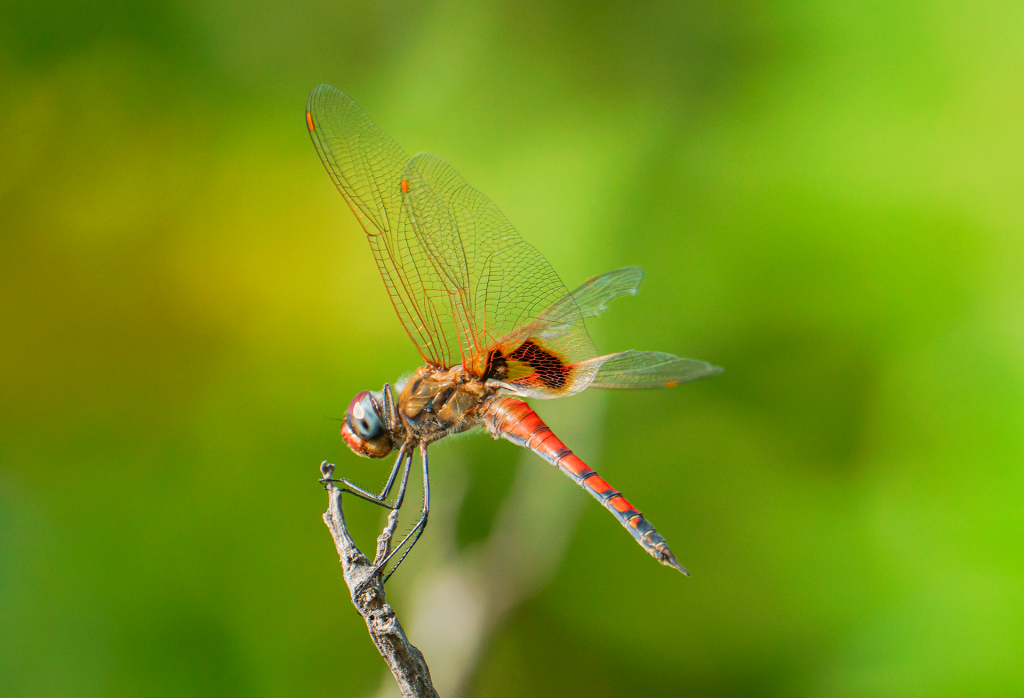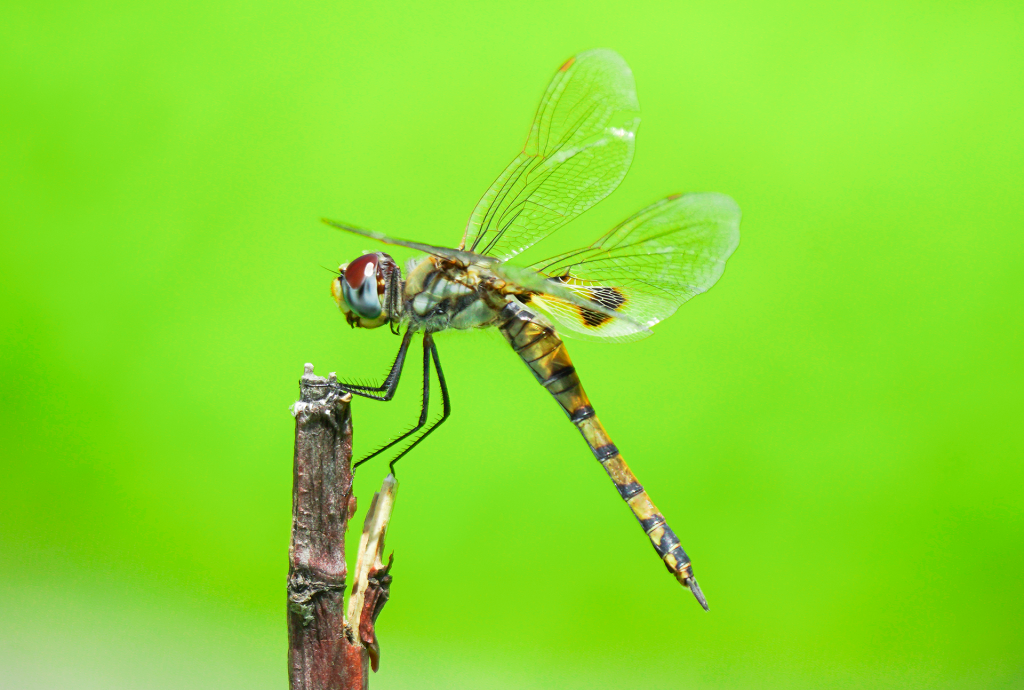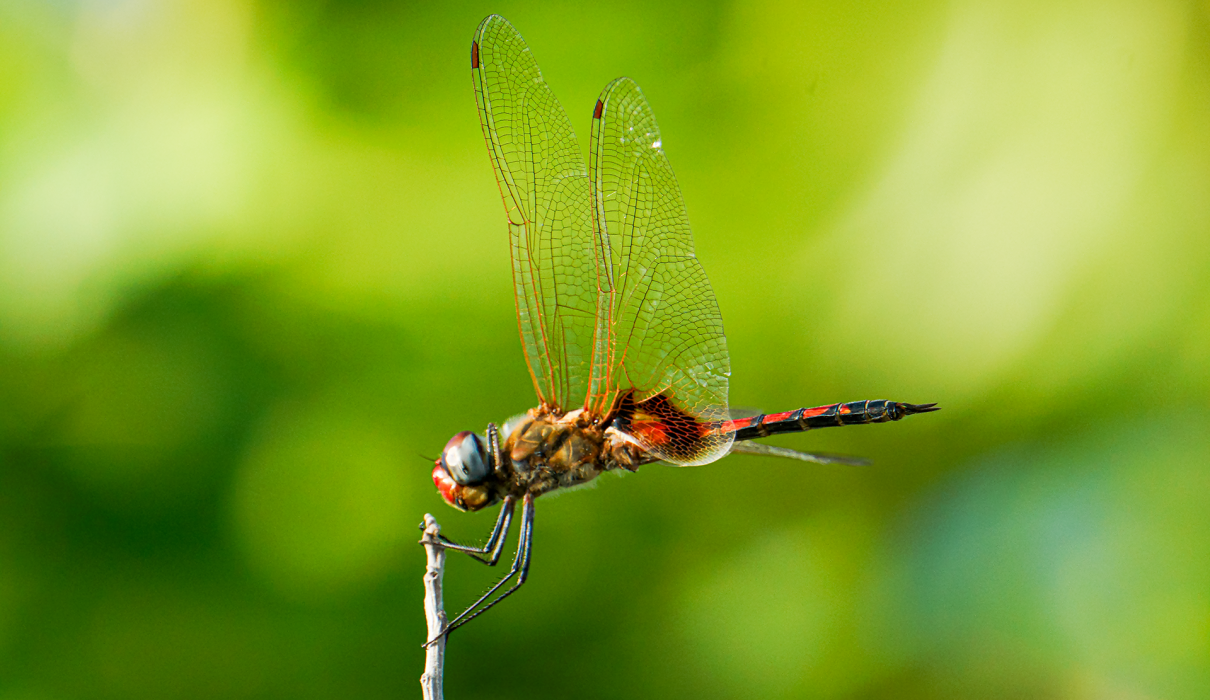Tramea basilaris, commonly known as the Keyhole Glider, is a species of dragonfly in the family Libellulidae. It is widely distributed across tropical and subtropical regions, including the islands of the Maldives. On Noonu Lhohi and various other islands, this species is frequently spotted near water bodies such as ponds, wetlands, and coastal lagoons. The Keyhole Glider is known for its strong, agile flight and its distinctive appearance, which makes it easily recognizable. This dragonfly is often observed gliding effortlessly through the air, especially during the warm months when it is most active.

Keyhole Glider (Tramea basilaris) male

Keyhole Glider (Tramea basilaris) Female
Taxonomy
- Kingdom: Animalia
- Phylum: Arthropoda
- Class: Insecta
- Order: Odonata
- Family: Libellulidae
- Genus: Tramea
- Species: Tramea basilaris
- Authority: Palisot de Beauvois, 1807
Description
The Keyhole Glider is a medium-sized dragonfly with a wingspan that can reach up to 8 cm. Its most distinguishing feature is the black patch, or “keyhole,” at the base of its hindwings, which gives the species its common name. The body is slender, with a dark thorax and an abdomen that is typically brown or reddish-brown. The wings are mostly transparent but display dark patches at the base, especially noticeable on the hindwings.
Male Tramea basilaris tend to have brighter, more pronounced colors than females, with more extensive wing markings. The eyes are large and compound, providing excellent vision for hunting prey in mid-flight. The legs are short and used primarily for catching and holding prey rather than walking.
Behavior
The Keyhole Glider is known for its strong and acrobatic flight, often seen gliding effortlessly over water bodies or open fields. In the Maldives, Tramea basilaris is commonly found around ponds, marshes, and coastal lagoons, where it hunts for small insects, including mosquitoes, flies, and other flying invertebrates.
This species is most active during the day, especially in the morning and late afternoon when temperatures are warm. It prefers sunny, open habitats where it can easily patrol for food. During its gliding flights, it frequently hovers or perches on vegetation near water bodies. In the Maldives, it has been observed in areas close to fresh or brackish water, making it a common sight on islands like Noonu Lhohi and beyond.
Habitat and Distribution
Tramea basilaris is distributed throughout tropical and subtropical regions, including Africa, Asia, and parts of Oceania. In the Maldives, the species is commonly found on multiple islands, particularly those with freshwater sources or wetlands. It thrives in a range of aquatic habitats, including ponds, lakes, marshes, and lagoons, where it lays its eggs and where its larvae develop.
The larvae, known as nymphs, live in the water and are voracious predators, feeding on small aquatic invertebrates and sometimes even tadpoles and small fish. Once they complete their development, the nymphs emerge from the water, molt into their adult form, and begin their life as flying insects.
Ecological Importance
As a predator of small insects, Tramea basilaris plays an essential role in controlling populations of mosquitoes and other pest species. Its presence in wetland areas helps maintain the ecological balance, as it regulates the number of prey species that might otherwise proliferate in the absence of natural predators.
The larvae of Tramea basilaris also contribute to the health of freshwater ecosystems by preying on other aquatic organisms, thereby playing a role in the food web. As both larvae and adults, these dragonflies help control insect populations and serve as prey for birds and other predators, making them an important part of both aquatic and terrestrial ecosystems.
Reproduction and Life Cycle
Tramea basilaris follows the typical dragonfly life cycle, starting with eggs that are laid in water. Females deposit their eggs by dipping the tip of their abdomen into the water while in flight. The eggs hatch into aquatic larvae, which live and grow in water for several months, depending on environmental conditions.
During the larval stage, the nymphs are highly predatory and well-adapted to aquatic life. They eventually undergo metamorphosis, emerging from the water as fully formed adult dragonflies. Adult Keyhole Gliders live for several weeks to a few months, during which they focus on feeding, mating, and reproduction.
Activity Patterns
Tramea basilaris is primarily active during the day, especially during the early morning and late afternoon. The species is often seen gliding or flying over open water or along the edges of ponds and wetlands. It prefers areas with abundant sunlight and open space, where it can easily hunt for insects and patrol its territory.
In the Maldives, this dragonfly is particularly noticeable during the dry season when water bodies become more accessible and insect prey is abundant. It is also a frequent visitor to temporary rainwater pools, which can form during the monsoon season.
Conservation
Tramea basilaris is not currently considered endangered, and it has a wide distribution across tropical and subtropical regions. However, like many species that depend on aquatic habitats, it is vulnerable to habitat degradation, including the pollution and destruction of wetlands. In the Maldives, where freshwater habitats are limited and subject to human activity, conserving wetlands and natural ponds is crucial for maintaining the population of the Keyhole Glider and other dragonfly species.
Efforts to protect and restore freshwater ecosystems, especially in island nations like the Maldives, will help ensure that Tramea basilaris continues to thrive in its natural habitat.
References
- Dijkstra, K-D. B., & Clausnitzer, V. (2014). “Dragonflies and Damselflies of Africa”. Royal Museum for Central Africa.
- Orr, A. G. (2003). “Dragonflies of the Malay Peninsula, Borneo, and Sumatra”. Natural History Publications.
- “Tramea basilaris”. Encyclopedia of Life. https://eol.org/pages/131069
- “Keyhole Glider (Tramea basilaris)”. iNaturalist. https://www.inaturalist.org/taxa/131069-Tramea-basilaris
- World Odonata List. “Tramea basilaris Palisot de Beauvois, 1807”. https://www.odonata.info


